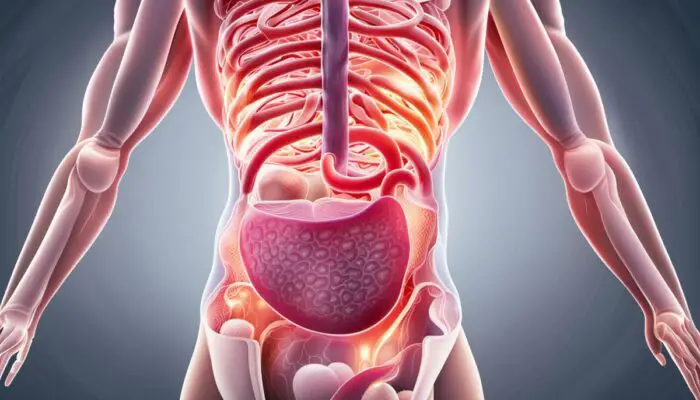As we navigate the complex world of healthcare, it’s essential to break down the intricacies of various conditions so that our understanding aids in better management and prevention. Inflammatory Bowel Disease (IBD), typified by the two different forms, namely, Crohn’s disease and ulcerative colitis, impacts an individual’s life significantly.
The symptoms, though common in many digestive disorders, present a unique pattern in IBD. Knowing what these signs are and how they influence one’s everyday activities is the first step towards a comprehensive understanding of this condition.
This text aims to provide a detailed overview of the diagnosis process, the deciphering of medical reports, and the array of available treatment options, all key components in the fight against IBD.
Understanding IBD: Types and Symptoms
Understanding IBD: Types and Symptoms
Inflammatory Bowel Disease, more commonly known as IBD, is a term used to describe two chronic conditions that affect the gastrointestinal (GI) tract – Crohn’s disease and ulcerative colitis. These conditions have numerous similarities and both are caused by an abnormal immune response leading to inflammation of the GI tract.
Crohn’s Disease
Crohn’s disease is an IBD type that can cause damage to any part of your digestive tract, from your mouth to the end of the bowel, known as the anus. However, the disease most commonly affects the lower part of the small intestine and the beginning of the large intestine. You might experience areas of severe inflammation alternating with healthy sections of bowel, recognized as “skip lesions”.
Common symptoms include persistent diarrhoea, abdominal pain and cramping, rectal bleeding, fatigue, and weight loss. The intensity of these symptoms can greatly vary from mild to severe and can also change over time.
Ulcerative Colitis
On the other hand, ulcerative colitis affects only the colon (large intestine). Unlike Crohn’s, which can cause inflammation through all layers of the intestinal wall, ulcerative colitis typically only inflames the innermost lining. The inflammation generally starts in the rectum and spreads upward in a continuous manner, potentially involving the entire colon.
Periods of diarrhoea, often with blood or pus, abdominal pain and cramping, rectal pain and a sudden need to defecate are typically indicative of ulcerative colitis. You may also experience weight loss and fatigue.
The Influence of IBD on Day-to-Day Life
IBD, also known as Inflammatory Bowel Disease, can extensively impact an individual’s quality of life. With potentialities like hospitalisations, surgeries, and long-term medical treatment, IBD can bring about considerable changes in an individual’s daily routine. Furthermore, experiencing symptoms like consistent diarrhoea and abdominal pains can impede attendance and performance in school, work, and social gatherings.
Diagnosing these conditions entails a comprehensive assessment, which includes a meticulous medical history review, complete physical examination, and a combination of laboratory and imaging tests. These might encompass blood tests, stool tests, endoscopies, and radiographic imaging.
Prompt detection of IBD is vital as it can circumvent complications and enhance an individual’s quality of life. If you surmise that you may be displaying signs of IBD, it’s crucial to consult your GP who can arrange for necessary investigations.
How IBD is Diagnosed: An Overview of the Process
Delving into IBD Diagnosis
Understanding the diagnosis of Inflammatory Bowel Disease (IBD), which encompases various gastrointestinal disorders, including Crohn’s disease and ulcerative colitis, requires insight into a comprehensive procedure. This procedure takes into consideration an individual’s medical history, physical examination, alongside various tests and procedures to conclude a diagnosis.
Medical History and Physical Examination
A physician typically begins the IBD diagnosis process by understanding the patient’s medical history. This involves a thorough discussion about the symptoms the patient has been experiencing. Common IBD symptoms include abdominal pain, chronic diarrhoea, unintentional weight loss, and fatigue. Besides, the doctor may also enquire about the duration of these symptoms and any family history of IBD. This is followed by a physical examination to look for signs of nutritional deficiency, bloating, abdominal tenderness, or unusual sounds in the abdomen.
Colonoscopy and Endoscopy
If the symptoms indicate a possible IBD, the clinician may recommend a colonoscopy or an upper endoscopy. A colonoscopy is a procedure in which a long, flexible tube that has a small camera attached to its end is used to examine the colon and the lower part of the small intestine for signs of inflammation, ulcers, or other abnormalities. The clinician might also take tissue samples for biopsy during this procedure. An upper endoscopy, on the other hand, is conducted to examine the upper part of the digestive tract, including the stomach and the esophagus.
Imaging Tests
Imaging tests like MRI (Magnetic Resonance Imaging), CT (Computerized Tomography) scans, and X-rays may also be used in the diagnosis of IBD. These tests provide detailed images of the digestive tract and can reveal abnormalities like inflammation, strictures (narrowing of the intestine), or fistulas (abnormal connections between different parts of the bowel or between the bowel and other organs).
Laboratory Tests
Clinical laboratory tests also form an integral part of the IBD diagnosis process. Blood tests can indicate signs of inflammation or anemia – both common in individuals with IBD. Stool tests are performed to look for signs of infection or blood, which is often found in patients with IBD.
To Conclude
The process of diagnosing Inflammatory Bowel Disease (IBD) is comprehensive, entailing a physical examination, thorough investigation of the patient’s medical history, procedures such as colonoscopy or endoscopy, various imaging tests and biopsies. Achieving an early and accurate diagnosis paves the way for efficient disease management, thereby improving the likelihood of successful treatment. Open lines of communication and informed discussions with healthcare professionals are crucial for anyone suspected of suffering from IBD.

Deciphering the Test Results: A Breakdown of Interpretations
Deciphering IBD Tests Results
Regardless of the specific type of IBD test you have undertaken, you may find the results bewildering, laden with a variety of complex medical terminologies. These results form a unique medical language, which often features an intricate array of markers, cells, substances, and can be either positive or negative. Nevertheless, familiarising yourself with these complex terminologies and their respective interpretations can greatly assist in understanding your health status.
Markers and Results
A significant aspect of IBD diagnosis is through pathology results, which evaluates the presence of inflammation in the tissues. This evaluation is often performed via endoscopic procedures (colonoscopy) or surgery. The laboratory technicians examine the samples microscopically, categorizing inflammation’s characteristics, location, and severity.
Some terminologies common among IBD diagnosis tests include granuloma, crypt distortion, and basal plasmacytosis, which signify different types of cellular-level changes. Granuloma, a form of tissue inflammation, is more common in Crohn’s disease, while crypt distortion and basal plasmacytosis are often associated with ulcerative colitis.
When interpreting whether a patient is ‘positive’ or ‘negative’ for certain markers, physicians consider the broader clinical picture. For example, a positive marker for inflammation would suggest the presence of IBD, but it must be taken in the context of other symptoms, test results, and individual factors such as age and health history.
Blood Tests
Blood tests for IBD aim to detect markers of inflammation, such as C-reactive protein or erythrocyte sedimentation rate. Higher levels of these markers are indicative of increased inflammation in the body. Additionally, complete blood count (CBC) tests help identify low red blood cell count (symptomatic of anemia) or high white blood cell count, both pointers towards potential inflammation.
Interpretation of Test Results
The interpretation of IBD test results is multifaceted and relies heavily on integrating results from various testing methods, including blood tests, imaging, endoscopy, and pathology reports. Physicians will evaluate the results collectively, keeping in mind the patient’s symptoms, medical history, and physical examinations.
It’s important to remember that while these tests are crucial in diagnosing IBD, they are sometimes not definitive. IBD can often present identical symptoms to other diseases and conditions, leading to the possibility of ‘false positives’ where outcomes might suggest the presence of IBD when it is not truly there.
Serology
Serology is another tool for IBD diagnosis. Serological tests assess the presence of certain antibodies against intestinal bacteria. Some of these antibodies are more commonly seen in people with IBD, while others may hint at differentiating between ulcerative colitis and Crohn’s disease. However, the results of serology do not invariably substantiate IBD presence, so it’s mostly exerted in conjunction with other diagnostic methods.
Overview
Grasping the lexicon and maintaining an ongoing dialogue with healthcare experts is crucial for comprehending your IBD test results. These outcomes offer a pivotal element in your IBD diagnosis, assisting medical professionals in delineating an all-encompassing view of your wellbeing. Subsequently, they are in a better position to decide the most suitable and effective treatment options.

Treatment Options: Navigating the Course of IBD
Therapy for Inflammatory Bowel Disease
Therapeutic treatments play an instrumental role in managing Inflammatory Bowel Disease (IBD). Medications commonly used include aminosalicylates, corticosteroids, immunomodulators, biologic therapies, and antibiotics. Aminosalicylates are typically employed to treat mild to moderate IBD symptoms, whilst corticosteroids act to suppress the immune system, hence, reducing inflammation. On the other hand, immunomodulators, which also suppress the immune system, are used when other treatments are unsuccessful. Biologic therapies focus on specific proteins linked to inflammation. Antibiotics aid in mitigating potential complications resulting from the disease.
Potential Side Effects of IBD Medications
There are, however, potential side effects and risks associated with each of these medication treatments. Some may include allergic reactions, increased risk of infection, skin rashes, nausea, steroidal side effects and in rare cases, a potential increased risk of developing certain types of cancer. It is fundamental to have an open dialogue with health professionals about these potential risks and any concerns.
IBD Surgical Treatment
Surgical treatment for IBD often provides relief when other treatments have been less effective. The types of surgeries performed often depend on whether the patients have ulcerative colitis or Crohn’s disease. For those with ulcerative colitis, the procedure typically involves removing the entire colon and rectum. Conversely, in the case of Crohn’s disease, only the diseased section of the bowel is removed.
Importance of Lifestyle Changes and Proper Nutrition
Managing IBD also heavily relies on lifestyle changes and proper nutrition. Adjustments may involve quitting smoking, regular exercising, and stress management which can significantly lessen the intensity and length of IBD flare-ups. Proper nutrition is also highly critical, and a balanced diet can assist in maintaining energy levels, providing necessary nutrients, and facilitating digestion. In specific cases, dietary supplements may be recommended to counter any nutritional deficiencies.
Navigating IBD Treatment Course
Navigating the treatment course of IBD can be complex given the broad range of treatment options and potentially severe impacts on one’s lifestyle and well-being. The treatment approach should be individualised, addressing the unique needs and concerns of each patient. A comprehensive team typically includes gastroenterologists, surgeons, dieticians, and mental health professionals, whose goal should be to manage the disease effectively, address symptoms, and improve quality of life. Having regular follow-up appointments to assess treatment effectiveness and to manage potential side effects is also of utmost importance.
Living with Inflammatory Bowel Disease (IBD) can be an arduous journey. Balancing everyday activities with the ever-present symptoms can put immense stress on one’s mental and physical well-being. Yet, with the right understanding of the condition, a strategic plan for diagnosis, a well-informed interpretation of test results, and thorough knowledge of treatment options, it becomes possible to navigate this course with confidence. Proper attention to lifestyle changes and nutrition can enhance the effectiveness of medication and surgery. Ultimately, gaining control over one’s life is plausible even with IBD, ensuring that the condition becomes a chapter of our lives rather than the entire book.
